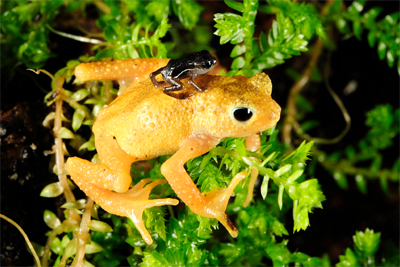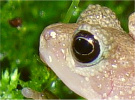One hundred Kihansi Spray Toads have been flown to their native Tanzania after a close brush with extinction, reports the Wildlife Conservation Society (WCS).
The species, which last year was declared extinct in the wild by the International Union for the Conservation of Nature (IUCN), was rehabilitated in captivity at the Bronx Zoo and the Toledo Zoo. Since 2004, when the toad was last seen in the wild, the captive population has climbed from a few hundred to nearly 7,000. For now, the toads—which unusually bear live young rather than laying eggs—reside in a new propagation center in Dar es Salaam, Tanzania, but plans are now in the works to eventually reintroduce the amphibian into its native habitat: the Kihansi Gorge in the Southern Udzungwa Mountains of South Central Tanzania, a region that possess the greatest biodiversity in all of Tanzania.
 A diminutive Kihansi spray toad newborn rests on the back of an adult female. Reared at the Bronx Zoo, these amphibians—now extinct in the wild—are part of an international program to reintroduce the Kihansi spray toad back into its former habitat in Tanzania. (credit: Julie Larsen Maher/Wildlife Conservation Society). |
“The return of these special creatures to Tanzania is a landmark achievement,” said Jim Breheny, Director of the Bronx Zoo and Wildlife Conservation Society Senior Vice President of Living Institutions, in a statement. “For years, the Bronx Zoo has been anticipating this important step toward reintroduction of the species, and we are ecstatic that the first toads are thriving in the new facility.”
“On behalf of the Government of the United Republic of Tanzania, we are very grateful to the Bronx Zoo and The Toledo Zoo for taking care of these precious toads for ten years,” said Anna Maembe on behalf of the Government of Tanzania. “We are very optimistic that they will acclimatize soon and be taken to their homeland in Kihansi Gorge in the near future.”
Damned by electricity demand
The return of the Kinhansi Spray Toad to Tanzania marks a dramatic turn-around for the species. The gold-colored toad was endemic to a five-acre micro-habitat created by the spray of waterfalls in the Kihansi Gorge but in 1999 the construction of a World Bank-sponsored dam, which now generates one-third of the country’s electricity, destroyed its habitat by dramatically reducing the flow of the the falls. The species went into rapid decline despite efforts to create a sprinkler system to augment the diminished mist-zone. Chytrid fungus, a deadly disease that has driven dozens of frog and toad species to extinction over the past 30 years, also turned up in the gorge, hastening the Kinhansi Spray Toad’s demise.
Facing almost certain extinction in the wild, the World Bank partnered with the Tanzanian government, the Toledo Zoo, and WCS’s Bronx Zoo, to save the species through a captive breeding program. Now the captive population in U.S. institutions have a level where 100 toads can go back to Tanzania.
“This is an important step that has been achieved through a lot of hard work,” said Jane Kibbassa, Task Team Leader for the Lower Kihansi Environmental Management Project which has installed a new sprinklers system to replicate the toad’s habitat. “The Bank has financed Tanzania’s commitment to save the Kihansi spray toad for nearly a decade, and has been looking forward to a successful reintroduction, which will be a measure of the recovery of the ecosystem and the success of the Lower Kihansi Environmental Management Project.”
Related articles
Bronx Zoo puts ‘extinct’ frogs on display
(02/02/2010) The Bronx Zoo has a put a most unusual frog on display: the Kihansi spray toad. For one thing, the Kihansi spray toad survived on only 5 acres in the Kihansi gorge in Tanzania, adapted to the areas’ unique and constant mist from the gorge and a waterfall. For another, female Kihansi spray toads give birth to live young, instead of laying eggs. Finally, the Kihansi spray toad is extinct—at least in the wild.
Kihansi spray toad goes extinct in the wild

(11/04/2009) This year’s IUCN Red List has updated its assessment of the Kihansi spray toad, moving the species from Critically Endangered to Extinct in the Wild. With that another amphibian species has been lost to a combination of habitat loss and the devastating amphibian disease, the chytrid fungus. The Kihansi spray toad Nectophrynoides asperginis, which still survives in a number of zoos in the United States, had lived on just two hectares along the Kihansi gorge in Tanzania. The toad was specially adapted to the spray region of the Kihansi waterfall, which kept its small environment at a constant temperature and humidity.
Toad on brink of extinction, scientists race to study for bioactive compounds
(06/29/2005) Following the construction of a dam in Tanzania, the Kihansi Spray Toad sits on the brink of extinction. Scientists are racing to study the amphibian for bioactive compounds with potential medical applications.

















